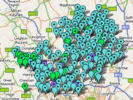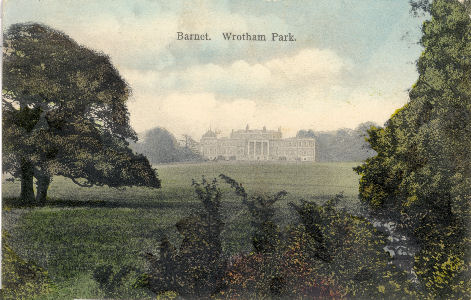|
Wrotham Park Barnet |
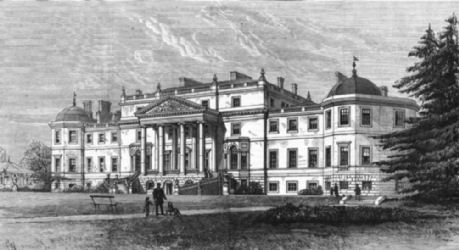 |
Wrotham Park, [Illustrated London News, 1883] |
|
Before the fire in 1883 |
Wrotham Park is a Palladian Mansion designed by Isaac Ware in 1754 for Admiral John Byng. It is not clear whether the Admiral every lived there as he was executed in 1757, under circumstances which prompted Voltaire to write "In this country it pays well, from time to time, to kill an Admiral to encourage the others". The House is still occupied by the Admiral's descendants, and is not open to the public, but available for private functions.
Wrotham Park is in the parish of South Mimms, which was in Middlesex until 1965, when it was transferred to Hertfordshire. However many earlier (and current) references describe it as Wrotham Park, Barnet - and Barnet was in Hertfordshire until 1965. The current postal address places it as Wrotham Park, Barnet, Hertfordshire - with an Enfield post code. For this reason Middlesex as well as Hertfordshire records may need to be examines to explore its history further,
Relevant Web Pages
Wikipedia: Admiral John Byng, Wrotham Park
Royal Naval Museum: Biography of John Byng
Wrotham Park Web Site: History
Parks & Gardens UK: Wrotham Park
|
|
8.3.08 Mrs Fyfe This is a view of Lady Strafford's estate & nice walking distance off Barnet. Two summers ago I took some of the old folks to tea there. One or two of them went fishing Little I? got the bait ready for them. Yours Lizzie Moor |
|
The following account and illustrations of Wrotham Park comes from the book Hertfordshire County Homes (1892), written anonymously by Truman Press and illustrated by F.G. Kitton. In reading the description it is important to realise that Truman Press produced a number of highly priced, high quality (in printing terms) books, which contain little but sycophantic accounts of the subscribers. In this context is is interesting that the account does not mention the execution of Admiral John Byng. |
A FINE substantial mansion, neither striking nor commanding, but of a solid, yet pleasing kind of architecture, is Wrotham Park House, the seat of the Earl of Strafford. Surrounded by innumerable clumps of majestic trees, the House, which is sufficiently elevated to command on one side an almost unrivalled panoramic view, is effectually obscured from the vulgar gaze of the pedestrians on the highway beyond. For picturesqueness of situation Wrotham Park probably ranks with the best of our county mansions, and being, as it is, within easy reach of Barnet. every lover of artistic Nature should take the opportunity of visiting it and revelling in its many splendours. Approached by a serpentine carriage-drive of noble width, the House is only little by little revealed to the expectant sight, but there is much to occupy the attention en route. Herbage of unstinted growth, trees of perfect form, and a graceful conservatory, with tall firs and wide-spreading cedars as companions, provide ample food for admiring contemplation. Winter, robed in her beautiful raiment of spotless white, may not particularly conduce to the prettiness of the landscape or enhance the loveliness of rural England, but, certainly, in gently throwing her mantle over the far away hill and dale and the near undulating and wooded plains, she makes the scene imposing, if not exquisite. It is not an aesthetic adornment, but one of grandeur, nevertheless. It was such a day when we, the artist and I, trudged over the few miles of inhospitable roadway from Potters Bar station to the modern little lodge at the entrance to the grounds. The land everywhere was covered with snow, which was even then falling in large flakes, and the effect, far from being monotonous, was very attractive. On every bough glistened the snow, crystallized by the night's frost, a touch of colour every now and then being given by the unexpected presence of the rich brown autumn leaf, lingering on, and yet reluctant to leave, while the accidental but appropriate location of bunches of evergreens considerably heightened the effect. It was a glorious sight, even in dreary mid-winter; what it must be in the soft glow of a charming summer's day, when the verdant cloak has been assumed, must be left to the imagination. Faulty conjecture must not be resorted to, however; personal investigation should solve the question.
After staying in front of the House sufficient time to note its style of architecture, we hurried inside to become the recipients of the hospitality of the obliging housekeeper, but before proceeding to chronicle what we saw inside I will briefly describe the appearance of the exterior. Presenting a long facade of distinctly Georgian style, the House possesses some elements of fine construction. Entrance is obtained by a few broad steps, and on either side the main exterior wall retreats, causing a cavity, each recess being sustained by two Doric pillars and capitals, abutting out again, the two extreme walls of the building run straight for a little distance, and then curve off gradually into the two comparatively short side walls. Surmounting the doorway are the coat of arms of the Byng family and the crest of the Earl, the owner of the domain. The rear of the house (of which an illustration is given) is really the principal front, its general characteristics being similar to those just feebly described - the indentations and capitalled pillars are present - while from the many windows overlooking the terrace and garden one may obtain a magnificent view of some of the finest scenery in the countryside.
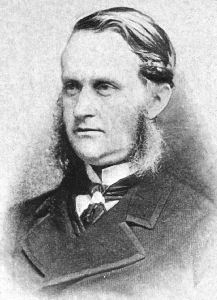 |
|
|
The Earl of Stratford |
In dealing with several particulars of the family of the noble owner of this handsome estate, gleaned from Debrett's Peerage and other sources not, perhaps, so authoritative, it is interesting to learn that the Earldom of Strafford is not of ancient origin, but, on the contrary, decidedly modern. The genial nobleman who now enjoys the title is only the third Earl, and only a few generations back the family were not blessed with the privilege of the endowment of nobility. The first holder of the title was John Byng, son of George Byng, Esq., of Wrotham Park, the latter being the son of the Hon. Robert Byng, who was the third son of the first Viscount Torrington. There was nobility, therefore, in the blood, but it was left for the aforesaid John Byng to ennoble this section of the family. He was born in 1772, and choosing the profession of a soldier, achieved the honourable distinction of Field Marshal, was created a G.C.B., then became a Knight of the Guelphs of Hanover, and was presented with several other distinguished orders. In 1835 he had conferred on him the honour of Baron, and in 1847 was made an Earl and Viscount in the peerage of the United Kingdom. He was twice married; by his first wife he had a son, George Stevens, who afterwards became the second Earl, but was summoned to the House of Lords during his father's life-time as Baron Strafford, and succeeded to the earldom in 1860. He married in 1829 Lady Agnes Paget, fifth daughter of the first Marquis of Anglesey, and again 111 18-+8 the Hon. Harriett Elizabeth Cavendish, second daughter of the first Lord Chesham. The Earl had thirteen children, the eldest of whom, Viscount Enfield, M.P., the present Earl, succeeded to the title in 1887, Her Majesty's Jubilee year. He is the secretary of the Poor Law Board, Lieut.-Colonel Commandant Royal Middlesex Rifles, and Colonel of the 29th Middlesex Rifle Volunteers. His lordship was born 22nd February, 1830, and married 25th July, 1854, Lady Alice Harriett Frederica Egerton, eldest daughter of Francis, first Earl of Ellesmere, K.G. He has had no children, consequently the heir to the title and property is his brother, the Hon. Lieut. Colonel Henry William John Byng, Coldstream Guards, who was born 21st August, 1831, and married, October 15th, 1863, Countess Henrietta Danneskiold-Samsoe, eldest daughter of his Excellency Count Christian Danneskiold-Samsoe. Colonel Byng has had three children, the eldest of whom, George Albert Edward Alexandra Byng, born in April, 1867 (at whose christening their Royal Highnesses the Prince and Princess of Wales stood sponsors), is the heir presumptive. The arms of the family, which have a resemblance to the Royal Arms, bear the motto " Tuebor": I will defend."
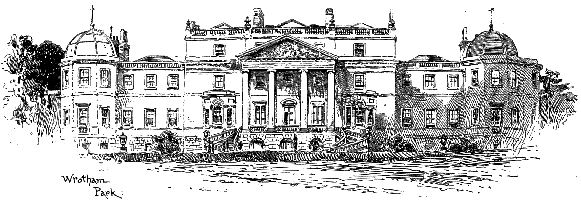
The residence of the two first Earls of Strafford, which was originally the property of John Byng, the father of the first Earl, was built probably about the middle of the 18th century, and existed without mishap until March 6th, 1882 [sic], when it was unfortunately razed to the ground by a terrible and inextinguishable fire. The old Earl and Countess and members of their family were present at the time, and old domestics relate with almost bated breath the indescribable confusion and excitement that prevailed, and how the aged Earl - he was then almost an octogenarian-had literally to be dragged out of the burning building. By singular good fortune the fire originated near the roof-through a defective flue it is presumed - and the time that the fiery element took to work its way downwards before it enveloped the building enabled the retainers to rescue all the family heir-looms and most valued possessions. Everything else perished, and included in them were several things it was really impossible to replace. The work of rebuilding at once commenced, but before the expiration of the contract the Earl died, and Viscount Enfield succeeded to the title. Under his direction the new mansion was completed - a counter-part of its predecessor - and, unless untimely destroyed by a similar fate, will weather the gales of many ages.
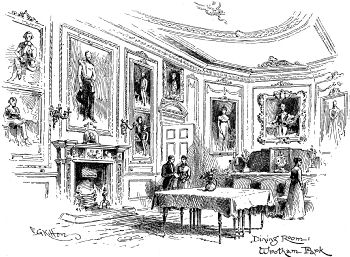 |
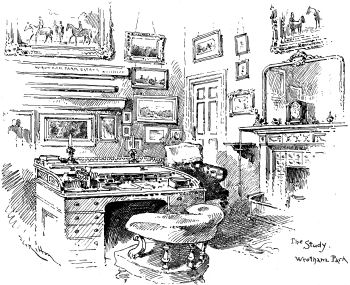 |
|
| The Drawing Room, Wrotham Park | The Study, Wrotham Park |
[The account continues with a detailed description of the interior of the house.]
| February 2010 | Page created | |
| March 2010 | Postcard of Wrotham Park |
